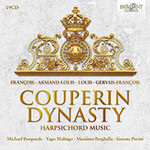
Couperin Dynasty
 $115.00
Out of Stock
$115.00
Out of Stock6+ weeks add to cart
THE COUPERIN FAMILY
Couperin Dynasty
Michael Borgstede, Yago Mahúgo, Massimo Berghella (harpsichords) Simone Pierini (fortepiano)
[ Brilliant Classics / 19 CD Box Set ]
Release Date: Friday 5 January 2024
This item is currently out of stock. It may take 6 or more weeks to obtain from when you place your order as this is a specialist product.
Admiration for the French composer, harpsichordist and organist, Louis Couperin continues to grow steadily today, but it was not so during his lifetime. The first important edition of his work in modern times, in its latest revision by Thurston Dart (used for this set), catalogues 129 pieces as authentic. Among these, the unmeasured Préludes stand out as a kind of 'controlled improvisation' in which the composer gives us a genre that began life in the hands of the lutenists and now finds itself at the very peak of 17th-century French harpsichord music. The rest of his music features dances typical of the suite form, including the Allemande, Courante, Sarabande, Gigue, Chaconne and Passacaille. Collectively, they help to place Couperin among the greatest composers of the 17th century alongside Frescobaldi, Chambonnieres, Froberger and D'Anglebert.
Though he wrote religious works as well as chamber music, harpsichord music forms the lion's share of Louis's nephew François Couperin's output: 235 pieces in all, most of them published in the four volumes (or Livres) of Pièces de Clavecin, divided into 27 ordres. Despite that designation, his first Livre, published in 1713, is hardly orderly. It seems Couperin simply grouped all the harpsichord music he had composed to that point into suites on the basis of keys in common. In four of the first five ordres of this Livre, dance forms such as the Allemande, Sarabande and Courante are interspersed amongst pièces de caractère composed in the popular stil luthé borrowed from the lute literature. Three years later, with the publication of the second Livre (1716), we meet a different Couperin. Here the relationship of the movements in each ordre is well thought out, and the style of the pieces strikes a balance between noble seriousness and joyous virtuosity. In the third Livre, Couperin definitively departs from the suite form: only the 17ème Ordre contains a dance, a lonely Courante. The tone of this book is tender and playful, exploiting the sonorities of the upper registers of the instrument. The fourth Livre, published in 1730, flows seamlessly on in the same vein, until the 25ème Ordre. Here the mood suddenly darkens. These final pieces - melancholy, exhausted, and perhaps slightly embittered - are the last works of a man who had no illusions about the finality of death.
Like the better-known Jacques Duphly (1715-1789) and Claude Balbastre (1724-1799), Armand-Louis Couperin belongs to the last generation of French harpsichord composers. He was the only child of Nicolas Couperin, who four years earlier had been appointed to succeed his cousin François as titular organist at the Église Saint-Gervais, and Armand-Louis was raised to follow in his father's footsteps, doing so at the age of 21 when Nicolas died. The modesty and success which profited Armand-Louis handsomely during his lifetime rather dimmed the light of his creative legacy. As his obituary remarks: he published little. One of only a few opuses, the magnificent volume of Pièces de clavecin for which he is best remembered deserves consideration alongside the viol fantazias of Purcell and the Lachrymae of Dowland, examples of lateness in music, where the fruit has ripened beyond high summer, yet there is much of interest in these pieces, beyond their historical value at the end of a distinguished family line.
Armand-Louis's son, Gervais-François Couperin, studied with his father then replaced him at the Sainte-Chapelle organ. He later succeeded his brother Pierre-Louis at Notre-Dame de Paris and held that post until the French Revolution. His keyboard compositions reveal a profound understanding of the delicate nuances and expressive capabilities of the harpsichord, characterized by elegance, refinement and meticulous attention to ornamentation. Yet Gervais-François was also a virtuoso on the new instrument of his day, the fortepiano, and this set features his music performed on that keyboard of greatly expanded expressivity.